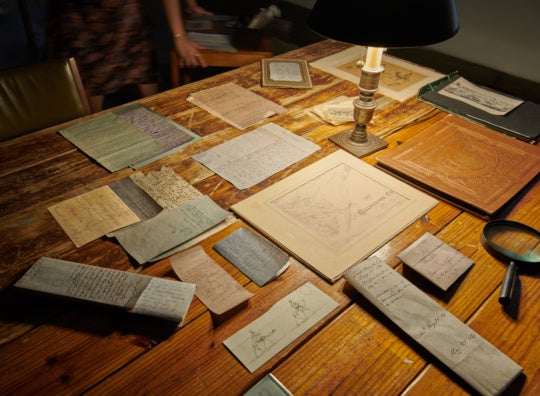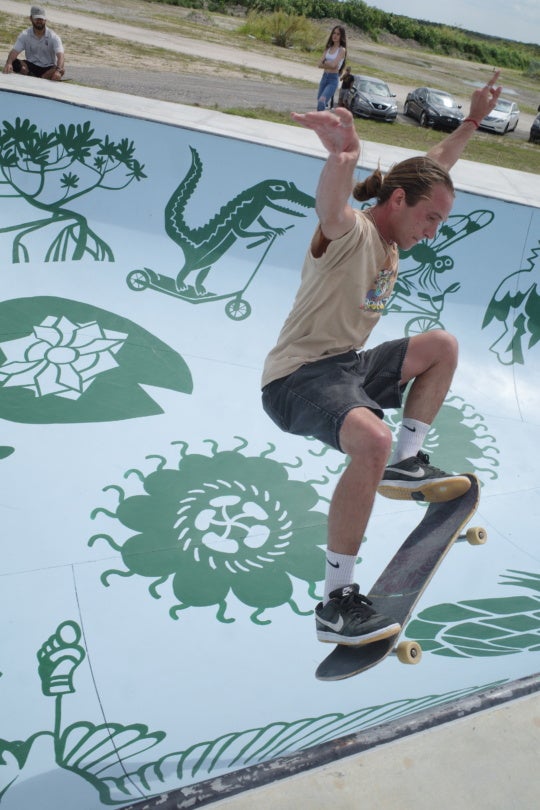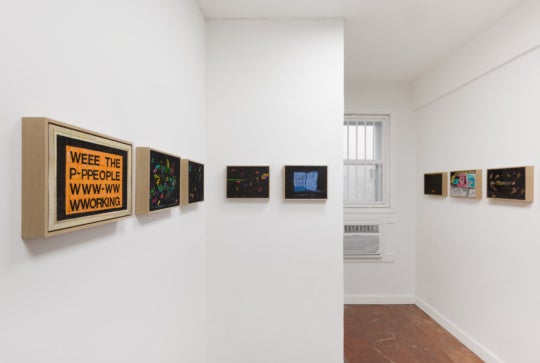Travel as a practice occupies varying roles in the life of each individual who embraces it–some are perfunctory, some are poetic. That artists so often lead double lives as travelers comes as no surprise, nor does their habit of keeping souvenirs. What is often surprising, however, are the myriad forms these souvenirs manifest when the artist returns from travel to the studio, and begins the process of emptying her experiences into her artistic practice.
At her core, New Orleans-based artist Teresa Cole is a traveler. Her primary interest lies in pattern–its various uses, shifts, and roles in culture. As a printmaker, Cole frequently purloins and manipulates patterns found in textiles, envelopes, foreign cultures, and her own surroundings in order to expose and question the ways in which information is transformed and utilized. Her multimedia practice takes the printed mark as its starting point, but her background in fibers frequently shifts her projects off of the page and into more dimensional manifestations.
Like the imagery she works with, her material decisions migrate freely, moving from paper, to fabric, to installation, and back again. Her current exhibition at Whitespace, From Origin to Present, highlights these tendencies with characteristic sophistication.

Entering the space, viewers are greeted by a suite of ten intaglio prints, whose soft undulations of black inks on white paper are interrupted only once by a wash of pale blue. In each work, patterns fade in and out of focus, referencing sea and plant life, stone and tile work. Moving vertically upwards through their rectangular compositions, her subjects flower, sharpen, fade, and soften.
In some moments, they look quite a bit like smoke captured and flattened onto an enormous microscope slide, as if prepared for scientific scrutiny. In others, their fuzzy edges and shifting focus recall pinhole photography, employed in service of a traveler’s documentation. I suspect both associations are relevant.
The reversed values of Stepwell Pattern II foreground the namesake’s looping, sinuous curls in lush, bold blacks, while Hook’s tension rests in an echo-filled landscape of negative spaces. The first room of the show is worth the trip alone, as Cole’s comfort with visual economy and atmosphere is on full display here, but this is only a primer for the main event next door.
Cole’s installation Curling in on Itself entirely dominates the second room of Whitespace’s gallery, forming a three-dimensional, sculptural form composed of over 400 individual components, hanging from the ceiling by multicolored embroidery threads. Each unit is a black-and-white relief print of a pattern (printed from Cole’s extensive backlog of hand-carved Masonite plates) adhered to a fragment of a traditional Indian sari, delicately curled at the lower edge.
Like all great work, it is impossible to photograph. Like all great work, to be alone with it in the space is not to be alone at all.
Created in total during a stint at Khoj International Artists Residency in Kolkata, India, Curling in on Itself is the impetus behind the exhibition as well as its title, From Origin to Present. Of the work, the artist writes, “The intent is to examine the malleability of sensory knowledge through layering enlarged marks and magnified views …. The objective is a tracing of the past to hopefully understand our complicated world. The need to recover an imagery’s origins, finding similarities and differences between cultures.”
In her travels, Cole’s ongoing research into pattern and its cultural roles led her to investigate the traditional patterns everywhere in India–on structures, on buildings, on clothing. When examined closely, they began to yield their relationships to more familiar and contemporary Western patterns (like those utilized in previous bodies of the artist’s work).
Curling in on Itself as a whole makes plain these connections–placing on each hanging component an example of the present and, on the reverse, a fragment of the past. It’s the artist’s configuration, however, that makes this research so engaging; as I stood alone with the work in the gallery, each hanging unit subtly shifted and swayed as it responded to the movements of my own body within the room.
That the work is so entirely responsive to its own viewership only deepens the propositions it posits. This particular formation of Curling in on Itself is the first occasion in which Cole has brought the work off the wall and entirely into the audience’s space. I hope, for the sake of its emphatic beauty, it won’t be the last.

Lightening the mood quite a bit across the patio is Girl Party, Kelly Cloninger’s charming installation in Whitespec (a project room space for the gallery). Cloninger’s precise and diminutive graphite drawings are clustered together throughout the basement space, against hand-painted walls of off-whites and pale greens.
To move through the small space entails wading through ankle-deep piles of the pinkest confetti I’ve ever seen in my life. Seriously, this stuff radiates girliness. It’s a perfect backdrop for Cloninger’s subject matter, which rebels against stereotypical images of feminism, focusing instead on (in the artist’s own words) “the celebration of all things ‘girl.’”
In nearly all of Cloninger’s compositions, women and girls enjoy various activities: happily chatting on the phone, throwing confetti, or smiling at the viewer while in the bath. Cloninger’s line work is precise and confident; her figures are quickly rendered with admirable economy and nuanced tone. Sporadic glitter, ink, and acrylic additions lend individual character to each piece. I’m impressed by her commitment, not to mention her skill.
Equally interesting is the anachronism of these images–surely, Cloninger’s source material must have included vintage advertisements and printed matter geared towards a female audience. Removing them from their original context opens up intriguing dialogues surrounding the female form, gaze, smile, and laugh. From a curtain of green, a toothy, smiling woman seems to croon into the phone, “Hey girl, how was your weekend? I spent mine subverting gender dynamics.”
Cloninger’s work has been popping up a lot lately, with recent group exhibitions at galleries such as Kibbee, Swan Coach House, and Young Blood. Girl Party is the first occasion I’ve been able to see such a generous helping of Cloninger’s work–I’m eager to see what comes next.
Kelly Cloninger’s exhibition, Girl Party, runs for its final day this Saturday, June 16, 2012, and Teresa Cole’s Between Origin and Present continues at Whitespace through Saturday, June 30.




